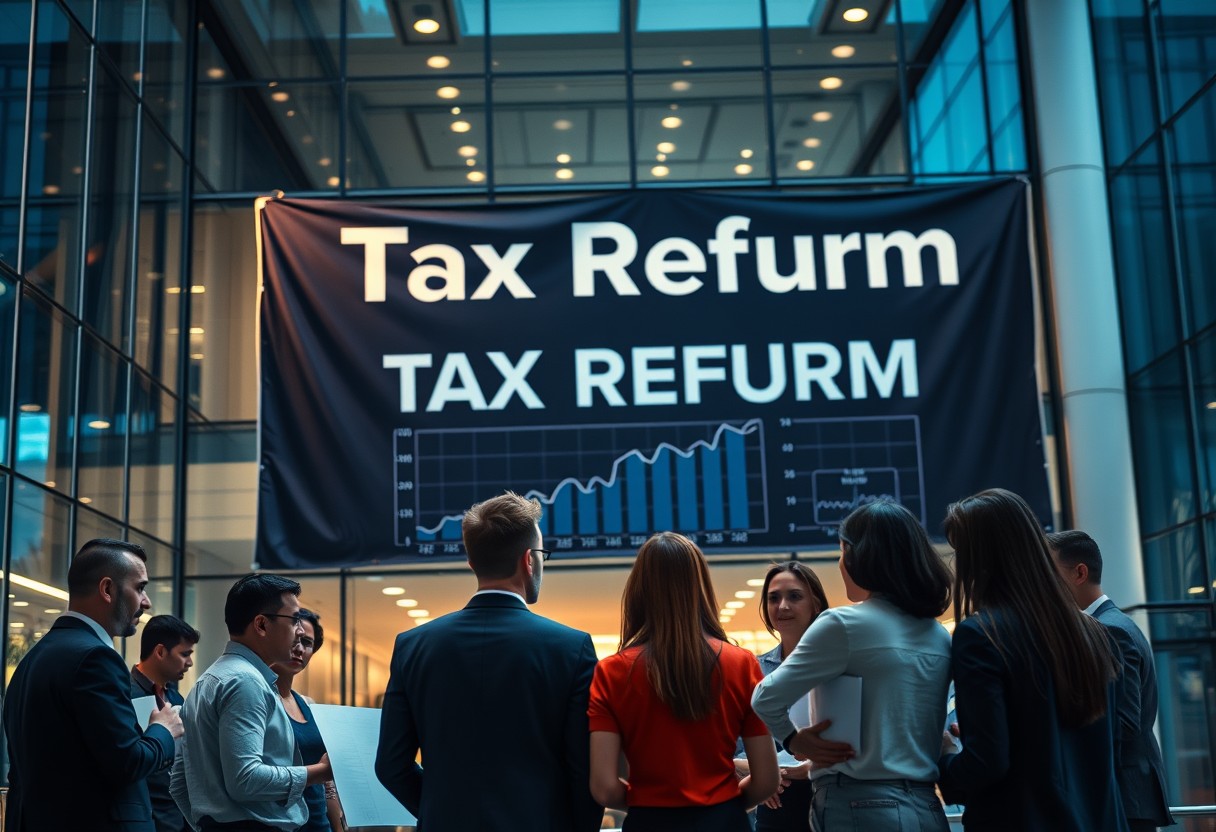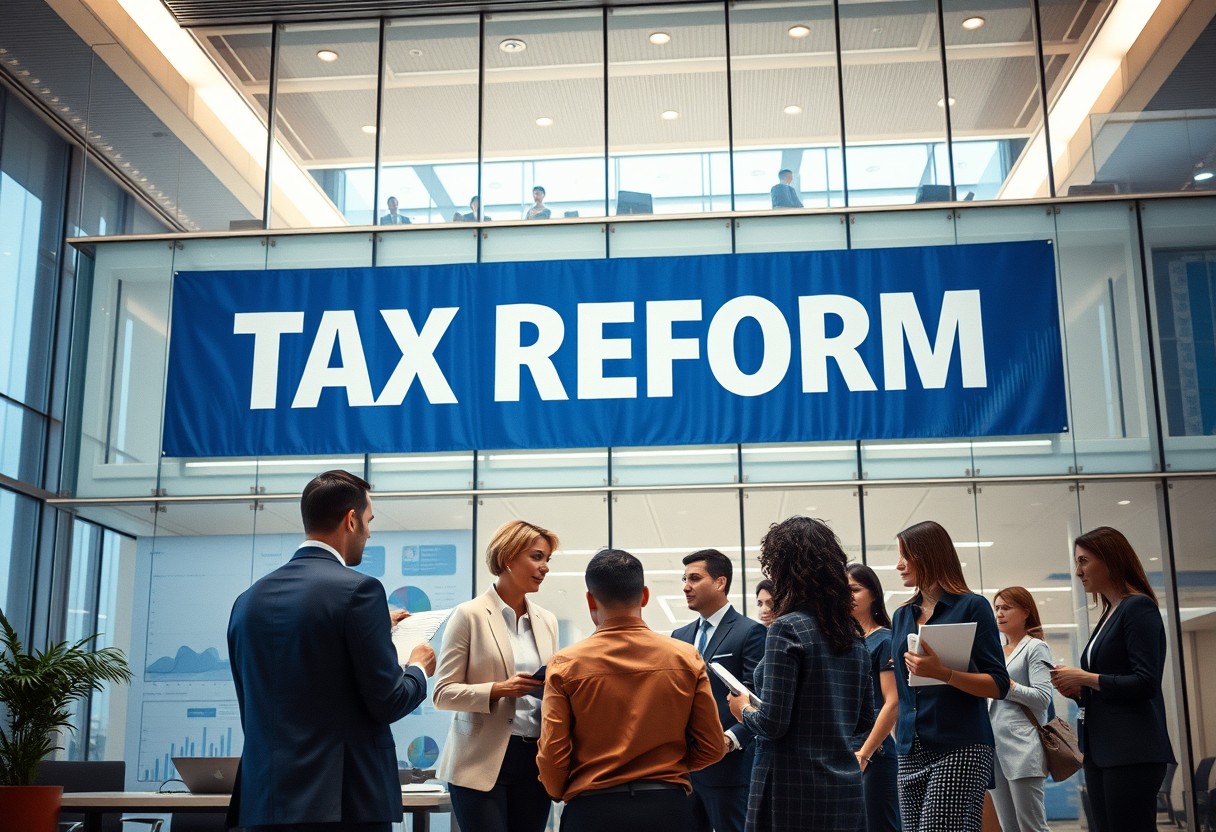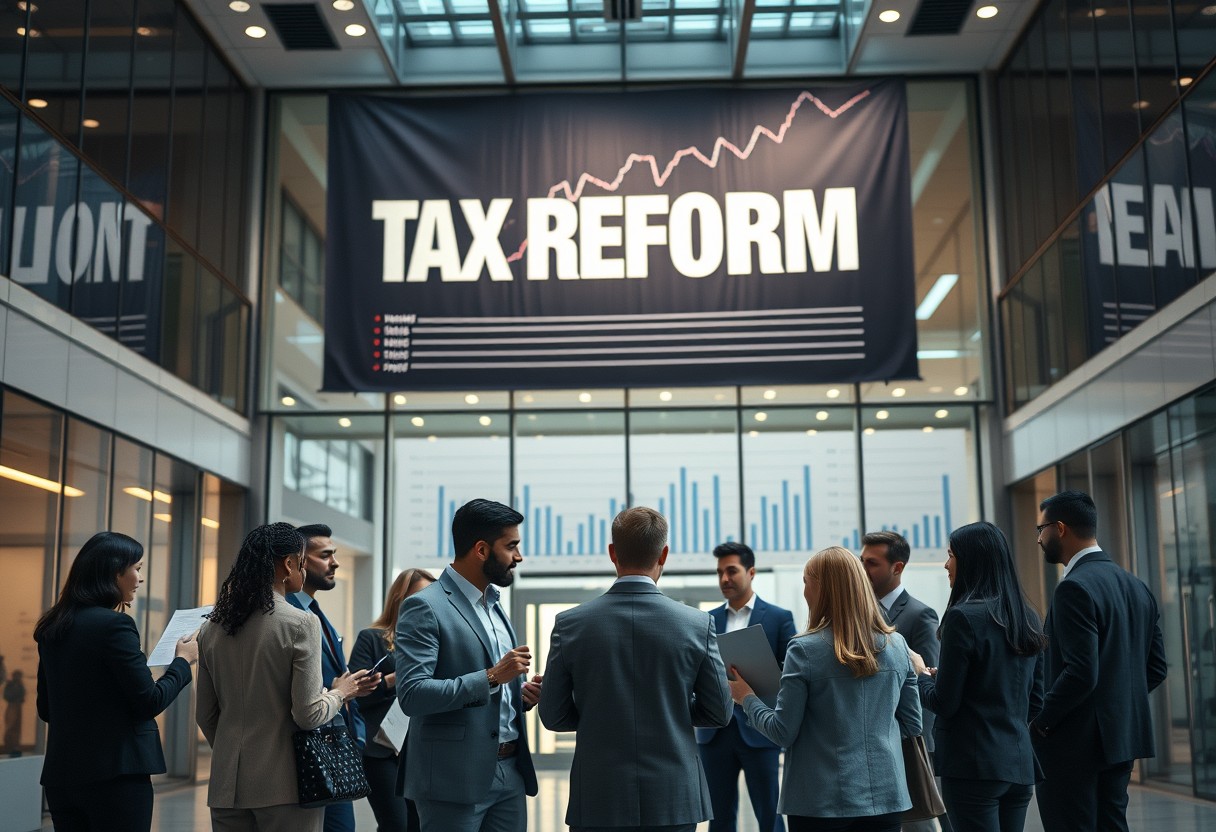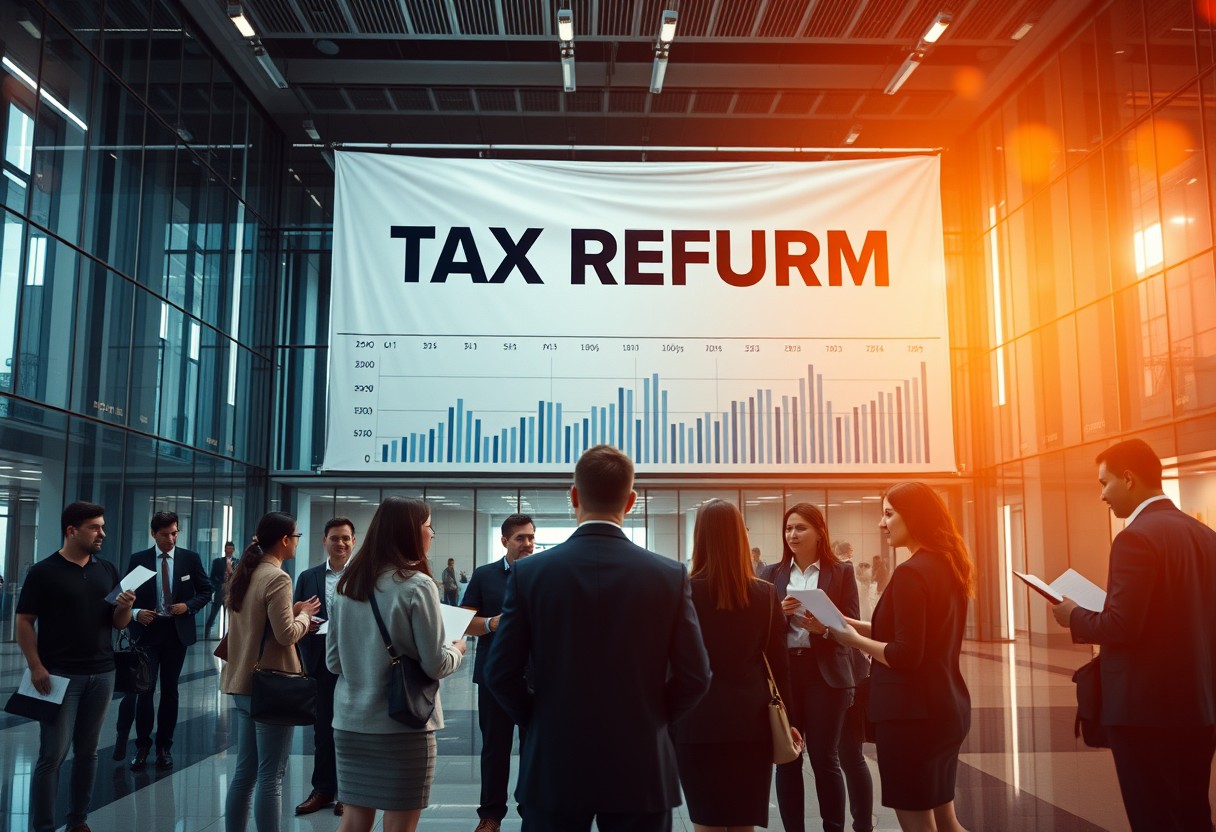Over the years, discussions surrounding tax reform have increasingly highlighted the potential benefits of a lower corporate tax rate. Experts argue that such a measure could stimulate economic growth, encourage business investment, and create job opportunities. However, they stress that it should be integrated into a comprehensive tax reform strategy that addresses inequalities and ensures fiscal responsibility. By examining the implications of a reduced corporate tax rate alongside other tax measures, policymakers can create a more balanced and effective tax system that supports long-term economic stability.
Key Takeaways:
- Economic Growth: A lower corporate tax rate can stimulate investment and drive overall economic growth.
- Global Competitiveness: Reducing corporate taxes can improve a country’s competitive position in the global market.
- Simplicity of Tax Code: Lowering the corporate tax rate should be part of a broader tax reform aiming for simplicity and efficiency.
- Job Creation: A lower tax burden on corporations often leads to increased hiring and job growth.
- Incentives for Innovation: Lower corporate taxes can boost R&D investments, fostering innovation.
- Revenue Considerations: It’s important to balance reduced rates with measures that ensure tax revenue stability.
- Broad Consensus: Bipartisan support for corporate tax reform can facilitate effective legislative change.

The Current State of Corporate Tax Rates
Historical Context of Corporate Taxation
The evolution of corporate tax rates in the United States has been shaped by a series of legislative reforms and economic events over the past several decades. Initially, the corporate tax rate was set at 50% in the 1930s. Following World War II, the rate fluctuated, reaching as high as 52.8% in the 1960s. However, in the early 1980s, the Economic Recovery Tax Act of 1981 significantly lowered the rate to 46% as part of broader taxation reforms aimed at stimulating economic growth. The Tax Reform Act of 1986 further reduced the corporate tax rate to 34%, reflecting a shift towards a more competitive tax structure intended to encourage domestic and foreign investment.
In the following years, various factors influenced subsequent adjustments to corporate tax rates, including economic recessions and changing political priorities. The Tax Cuts and Jobs Act of 2017 represented a historic shift, reducing the corporate tax rate to 21%. Proponents argued that the reduction catalyzed economic growth, while critics contended it disproportionately benefited billion-dollar corporations at the expense of necessary public services. The interplay of these rates with economic performance demonstrates the ongoing debate about the relationship between corporate taxation and economic prosperity.
International Comparisons
Across the globe, the United States has traditionally maintained one of the highest statutory corporate tax rates. As of the latest analysis, the 21% corporate tax rate contrasts with the average corporate rates seen in other major economies, which typically hover around 20%. This discrepancy raises questions about the attractiveness of the U.S. business environment compared to countries with more favorable tax regimes. The effective tax rates, which reflect deductions and credits, further emphasize this contrast, as they can significantly lower the actual tax burden faced by corporations.
As firms increasingly consider the total tax burden in their operational decisions, comparisons with countries like Ireland (where the corporate tax rate is notably lower at 12.5%) and Canada (which has a combined federal and provincial rate around 26.5%) become necessary. These differential rates can directly impact foreign investment and drive companies to explore relocation options to maximize profitability. The perception of the U.S. tax structure plays a pivotal role in shaping these business decisions.
International Corporate Tax Rates Comparison
| Country | Corporate Tax Rate |
|---|---|
| United States | 21% |
| Ireland | 12.5% |
| Canada | 26.5% |
| United Kingdom | 19% |
| Germany | 30% |
Around the world, countries are competing to attract multinational corporations through favorable tax policies. The apparent disparity in U.S. corporate tax rates compared to nations with substantially lower rates invites ongoing discussion regarding reform. Policymakers are increasingly recognizing that lowering rates could position the United States more competitively on the global stage. This assessment often drives legislative proposals to reevaluate and possibly amend the current corporate tax structure.
Factors Influencing Corporate Tax Rates Internationally
| Factors | Description |
|---|---|
| Attracting Foreign Investment | Lower corporate tax rates can incentivize foreign companies to establish operations in a country. |
| Business Relocation | Highly taxed jurisdictions risk losing businesses to countries with more favorable tax conditions. |
| Global Corporate Mobility | Companies are increasingly factoring in tax implications as they evaluate global business strategies. |
Public Perception and Political Debates
In addition to economic factors, public opinion on corporate taxation significantly shapes political discussions and policymaking processes. There exists a divide between those who advocate lowering corporate tax rates to stimulate growth and those who argue for maintaining or increasing them to ensure that corporations contribute fairly to societal needs. Supporters of lower rates contend that tax relief for businesses encourages investment, job creation, and ultimately benefits the economy as a whole. Critics, however, assert that lower corporate taxes disproportionately favor wealthier corporations, potentially exacerbating income inequality and underfunding necessary services.
After the introduction of the Tax Cuts and Jobs Act in 2017, the debate intensified, with both sides presenting compelling arguments. Proponents celebrated immediate benefits for corporations, while opponents raised concerns over long-term fiscal consequences. The political landscape remains polarized, with calls for reform often reflected in the agendas of both major political parties. (Major companies’ differing perspectives on these policies continue to fuel the debate.)
After further analysis, the public sentiment surrounding corporate taxes remains complex and multifaceted, influencing proposed changes and reforms. The persistent focus on equity and fairness in taxation continues to drive discussions among policymakers. (Recent surveys indicate that a significant portion of the public favors raising taxes on large corporations.)
Perception is key in understanding the broader implications of corporate tax structure reforms. Stakeholders, including voters, businesses, and policymakers, assess how taxation aligns with their priorities and values. The dynamics of public opinion will undoubtedly play a vital role in future conversations about corporate tax rates and necessary reforms.
Economic Implications of Lower Corporate Tax Rates
Clearly, the economic implications of lower corporate tax rates are significant and multifaceted. One of the most immediate effects is the stimulation of business investment. When corporations face lower tax burdens, they have more capital available for reinvestment. This can lead to increased capital expenditures, expansion into new markets, and ultimately, job creation. Empirical evidence from previous tax cuts, such as the Tax Cuts and Jobs Act of 2017 in the United States, illustrates that many companies used their tax savings to enhance their facilities, invest in technology, and initiate hiring rounds. (Decisions regarding tax policy can shape the landscape of the economy for years to come.)
Impact on Business Investment
Any reduction in corporate tax rates tends to create a more favorable environment for business investment. By lowering the cost of capital, businesses often feel encouraged to take on new projects that may have previously seemed too risky due to high tax obligations. Studies indicate that the 2017 tax legislation resulted in a surge in capital expenditures among leading firms, which subsequently contributed to an overall uptick in economic growth. Such outcomes highlight a direct correlation between lower corporate tax rates and the capacity for businesses to expand operations and create jobs. (In evaluating these strategies, policymakers must consider the broader implications of tax reform.)
Effects on Wages and Employment
Against the backdrop of lower corporate tax rates, there is also a noteworthy correlation with wage growth and job creation. Research indicates that as businesses benefit from lower taxes, they often allocate some of these savings towards employee compensation. This relationship suggests that a favorable corporate tax climate can lead to increased wages alongside job creation. For instance, a 2021 report demonstrated that companies investing in their workforce post-tax cuts saw increments in base pay, particularly in the technology and manufacturing sectors. (Decisions around corporate taxation could thus significantly influence employee remuneration strategies.)
The impact of lower corporate tax rates on wages and employment has been a subject of much debate. While critics argue that businesses might not always translate tax savings into higher wages, data suggests that many firms recognize the importance of attracting and retaining talent in a competitive labor market. This recognition can lead to a more robust workforce, which not only benefits employees but also bolsters overall productivity. (Understanding the nuances of corporate taxation can help frame effective economic policies.)
Influence on Innovation and Productivity
The relationship between corporate tax rates and innovation is a critical one. When tax rates are reduced, corporations find themselves in a better position to invest in research and development (R&D) initiatives. These investments are paramount in enhancing productivity and developing new products or technologies. Case studies from countries that have enacted significant tax reforms demonstrate an uptick in innovation post-reform, showcasing how fiscal policy can influence corporate behavior positively. Tax incentives play a vital role in encouraging companies to dedicate resources towards improving operational efficiencies and pioneering new solutions. (Considering the long-term impact of these decisions is crucial.)
Impact analysis shows that companies operating in a lower tax environment have been more inclined to increase their investment in R&D, resulting in higher levels of productivity over time. For example, there are instances where companies that experienced tax cuts have noted improvements in innovation cycles, transforming ideas into market-ready solutions more swiftly. This not only benefits the companies but also enhances competitiveness on a global scale. (Evaluating the long-term consequences of tax cuts is therefore vital for future economic strategies.)
Understanding these economic implications helps to create a comprehensive picture of how lower corporate tax rates can serve as a beneficial element within broader tax reform. By considering investment, wage growth, employment rates, innovation, and productivity, policymakers can assess the multifaceted advantages that may arise from strategic reductions in corporate tax obligations.
Broader Tax Reform Considerations
Unlike isolated tax policy changes, broadening the scope of tax reform to include a lower corporate tax rate can yield a multifaceted impact on the economy. It is vital for policymakers to consider how these changes fit within the overall tax landscape. Research has shown that a Corporate Rate Increase Would Make Taxes Fairer, Help …, but this must be accompanied by a broader agenda to genuinely enhance fairness and efficiency in the system.
Simplification of the Tax Code
At the core of effective tax reform lies the simplification of the tax code. Lowering corporate tax rates should be part of a comprehensive effort to streamline tax regulations, which would not only enhance compliance but also reduce administrative costs for both businesses and government agencies. By minimizing the complexity of the code, these reforms can bolster overall economic efficiency and create a more equitable environment for taxpayers. (The challenge lies in determining the optimal balance of maintaining sufficient revenue while simplifying intricate rules.)
Moreover, a simplified tax structure can lead to increased clarity and predictability, encouraging businesses to invest and grow. He or she who navigates a less convoluted system is more likely to fulfill tax obligations timely, fostering a culture of compliance and consistency. Implementing these changes would allow for better allocation of resources, thus contributing to a healthier economy overall.
Addressing Tax Inequality
To address the potential disparities that may arise from lowering corporate tax rates, it is necessary to introduce measures aimed at reducing tax inequality. Policymakers must ensure that tax reforms do not disproportionately benefit the wealthy, thereby deepening existing economic divides. Striking a balance is vital—tax relief initiatives should target both corporations and individual taxpayers in lower income brackets to promote a more equitable distribution of wealth. (A comprehensive approach involving targeted tax credits or incentives could effectively address these concerns.)
And while proponents argue that reducing corporate taxes can stimulate job creation and increase wages, it is imperative that such changes are accompanied by reinvestment in social programs and infrastructure that support the broader population. This strategy not only mitigates the risks of exacerbating inequality but also ensures that the benefits of a lower corporate tax rate are felt across all levels of society, enabling true economic growth.
Ensuring Fiscal Responsibility
Code concerns surrounding fiscal responsibility must be front and center when considering any form of tax reform. Lowering the corporate tax rate could have significant implications for public revenues, budget deficits, and the sustainability of social services. Legislative bodies need to carefully weigh these changes against their potential consequences for fiscal health. (Making informed decisions about where revenue is sourced will be vital in maintaining public service levels while enacting tax reforms.)
Fiscal sustainability should be a key tenet of any tax reform initiative. They must seek to balance stimulating economic growth through lower taxes with the necessary funding required for public services. It is imperative that policymakers ensure this equilibrium, utilizing diligent assessments to anticipate how a shift in revenue structures might influence long-term fiscal stability and overall societal well-being.
Fiscal discipline will always be an necessary part of maintaining economic growth. Therefore, she or he who prioritizes responsible fiscal practices while advocating for a more equitable tax system will ultimately contribute to a healthier economy. Ensuring transparency and accountability in these reforms is not simply wise; it is necessary for long-term success.
Policy Options for Implementation
Despite ongoing debates about corporate tax reform, policymakers must consider various strategic approaches to implementing lower corporate tax rates. Among these approaches, the choice between gradual reductions and immediate cuts presents both advantages and disadvantages. A gradual decrease allows corporations to adjust to the new tax landscape, potentially providing a more stable economic environment and reducing sudden revenue losses for the government. Conversely, immediate cuts can stimulate investment quickly, leading to faster economic growth, but they may also create volatility in fiscal planning.
Gradual vs. Immediate Rate Reductions
Among the potential implications of immediate rate reductions is the rapid influx of corporate investments that may bolster job creation and economic expansion. However, this approach could also strain existing government revenue models and lead to budgetary challenges if not managed carefully. On the other hand, gradual reductions can help smooth the transition, encouraging businesses to engage in long-term planning. This approach tends to be more popular among legislators because it allows time to assess the impacts of tax reform and make adjustments as necessary.
Targeted Incentives and Credits
Gradual reductions in corporate tax rates can be complemented by implementing targeted incentives and credits aimed at specific sectors or activities. For example, renewable energy companies could receive credits, encouraging investment in sustainable practices while aligning with broader environmental goals. Similarly, small businesses may benefit from targeted deductions related to job creation, thereby fostering local employment growth. This approach not only eases the financial burden on companies but also stimulates economic development in key areas.
In fact, these targeted incentives can play a significant role in directing corporate activity toward national priorities, such as technological innovation or infrastructure improvement. By strategically offering tax credits and deductions, lawmakers can create a tax environment that supports sectors likely to generate widespread benefits, ensuring that corporate tax reform aligns with long-term economic goals.
State-Level Considerations
In the context of federal corporate tax reforms, it is vital for legislators to consider how such changes will impact state-level tax structures. Variability in state corporate tax rates means that local economies may experience different levels of benefit from federal reforms. For instance, states with higher corporate tax rates may see an influx of businesses seeking more favorable conditions, while those with already lower rates may need to assess their competitiveness in attracting corporations. (Governors must balance the desire for a competitive tax rate against the need for adequate funding for public services.)
Reductions in federal corporate tax rates could significantly affect state revenue models, requiring states to strategize on how to maintain public services while incentivizing business growth. States worried about losing corporate tax revenue might consider adjusting their policies to offer more competitive rates or additional incentives. (Some may even engage in interstate tax competition to attract new businesses.)
Incentives such as tax credits and deductions can be tailored to support state economic development initiatives, allowing state-level policymakers to encourage specific industries that align with local goals. These tax breaks can help foster regional business clusters and stimulate job growth, ultimately enhancing the overall economic resilience of his state.

Case Studies: Successful Tax Reforms
All initiatives aimed at reforming corporate tax rates provide a wealth of insights into potential benefits and outcomes. A survey of successful tax reforms globally reveals that lowering corporate tax rates often correlates with enhanced economic performance, increased investment, and job creation. Here are several notable case studies that illustrate these outcomes:
- United Kingdom: In 2010, the UK government began gradually lowering the corporate tax rate from 28% to 19% by 2017. This change was associated with a 45% increase in foreign direct investment (FDI) and a significant boost in GDP growth from 1.7% in 2010 to over 2.5% by 2017.
- Ireland: Ireland’s corporate tax rate has been set at a low 12.5% since 2003. This policy has attracted many multinational companies, leading to an increase in FDI from €20 billion in 2004 to more than €80 billion by 2019, along with an impressive economic growth rate averaging 7.5% annually.
- Canada: In 2012, Canada reduced its federal corporate tax rate from 16.5% to 15%. This adjustment contributed to a 20% rise in investments over the next five years and improved the country’s overall labor productivity by 15% during the same period.
- Australia: Australia has gradually lowered its corporate tax rate from 30% to 25% for small businesses. This reduction has resulted in a 14% increase in small business employment and a substantial rise in overall business activity.
The 2017 Tax Cuts and Jobs Act
At its core, the Tax Cuts and Jobs Act (TCJA) of 2017 sought to lower the federal corporate tax rate from 35% to 21%. This unprecedented cut was part of a broader effort to drive economic growth, increase investments, and enhance job creation. The immediate aftermath of the TCJA saw a notable increase in capital expenditures, with S&P 500 companies announcing upwards of $1 trillion in stock buybacks and capital investments shortly after the reforms took effect. Additionally, unemployment rates fell dramatically, reaching a 50-year low by the end of 2019.
At the same time, critics of the TCJA pointed to rising income inequality and questioned whether the benefits of tax cuts would trickle down as intended. Many corporations utilized the tax savings for stock buybacks rather than substantial employee wage increases. Nevertheless, the act did contribute to a surge in the U.S. economy’s overall output, with real GDP growth averaging 2.9% from 2018 to 2019.
International Case Studies
At the international level, several countries have showcased the benefits derived from lowering corporate tax rates. For instance, Hungary established a corporate tax rate of just 9% in 2017, the lowest in the European Union. This policy change has led to a remarkable 4% growth in GDP and job creation in key sectors such as technology and pharmaceuticals. Similarly, in 2018, Singapore maintained a corporate tax rate of 17%, attracting numerous global firms and resulting in a 25% increase in investments that bolstered economic stability and growth.
- Hungary: Corporate tax reduced to 9% in 2017; reported GDP growth of 4% annually post-reform.
- Singapore: Maintained a steady 17% corporate tax rate, resulting in a 25% increase in FDI from 2017 to 2021.
- Georgia: Implemented a 15% corporate tax rate in 2016; saw an influx of FDI, increasing from $1 billion to $1.2 billion by 2020.
- Estonia: Adopted a unique 20% corporate tax system only on distributed profits, leading to substantial investments in technology and innovation.
Behind these successful case studies, several common themes emerge concerning tax reforms. Nations that proactively engage with businesses and create transparent fiscal frameworks generally witness greater economic dividends. They emphasize collaboration between the public sector and private enterprises to optimize investment and job creation. (An important decision regarding the balance between lowering rates and ensuring sufficient public revenue must be navigated cautiously.)
- Denmark: Reduced corporate tax rate to 23.5% and witnessed more than 130% growth in tech startups in subsequent years.
- New Zealand: Achieved a corporate tax rate of 28% while maintaining GDP growth of 3% annually through sound fiscal policy.
- Germany: Adjusted corporate tax rates and reported a 1.5% annual growth in the manufacturing sector, driven by investments.
- Bulgaria: Implemented a flat 10% corporate tax, significantly increasing foreign investment inflows by 30% post-2010.
Lessons Learned
Jobs are vital to economic stability, and analyzing U.S. and international experiences with corporate tax reforms reveals critical takeaways. Firstly, he notes that lowering corporate tax rates must be accompanied by responsible fiscal management to avert budget deficits. Countries that have successfully implemented tax reductions often backed these reforms with measures to maintain transparency in governance and attract investment. Some pitfalls to avoid include over-reliance on short-term economic benefits without assessing long-term sustainability and equity impacts.
Jobs and economic performance do not exist in a vacuum; they are influenced by a multitude of intersecting policies. Successful tax reforms typically involve stakeholder engagement, ensuring that diverse perspectives are considered throughout the process to minimize unintended consequences. (A balanced approach that considers both the benefits to corporations and the needs of the public is important for sustainable tax reform.)
Lessons Learned Continued
International lessons from tax reform experiences highlight the importance of continuous assessment of the impacts of lower corporate tax rates on various socio-economic groups. Engaging in comprehensive analysis and developing adaptive strategies while implementing reforms is also necessary for sustained success. (Fostering a collaborative environment among stakeholders can lead to innovative solutions and enhanced economic prosperity.)

Future Directions for Corporate Tax Reform
For individuals observing the shifting dynamics of corporate tax reform, it is evident that political landscapes play a significant role in shaping potential outcomes. As noted in the 15% Trump Corporate Tax Rate: Details & Analysis, the partisan divide affects the feasibility of reducing corporate tax rates. In times of a more favorable political climate for tax reform advocates, there may be increased possibilities for reconsidering lower corporate tax rates. Conversely, a shift towards more progressive policies could stall or even reverse these efforts, complicating the tax landscape. The oscillation between favoring corporate interests and emphasizing social equity places corporate tax reform initiatives in a precarious position where consensus remains difficult to achieve.
Political Landscape and Change
Any meaningful movement towards tax reform is greatly influenced by the prevailing political sentiment. If the tides favor proponents of lower corporate taxes during a legislative session, there may be opportunities to implement lower rates as a part of broader reform. However, political resistance may emerge if the opposing parties rally against perceived corporate benefits, leading to diverging priorities and limiting the window for substantial tax changes. Moreover, as political affiliations evolve, so too will the arguments both for and against corporate tax reductions, shaping public opinion and legislative priorities.
Global Trends in Corporate Taxation
Any examination of U.S. corporate tax reform must take into account the international context, where competition among nations for business investment plays a pivotal role. A lowering of corporate tax rates may not only align with domestic objectives but also serve to attract foreign investment amid pressures from countries launching on their own tax cuts. Additionally, the rise of digital taxation initiatives across various countries adds a layer of complexity for U.S. policymakers, who must navigate the implications of global standards while considering the competitive advantages a lower tax rate could confer. (The European Union has recently signaled intent to approach digital taxation collaboratively.)
Across the globe, multinational corporations are facing increased scrutiny over their tax strategies, with many countries adopting measures that specifically target digital services. Coupled with the ongoing discourse surrounding tax competition, the U.S. may find itself at a crossroads. They must balance the benefits of potentially lowering corporate tax rates in order to remain competitive against the backdrop of these international trends. (An important agreement was reached among G20 countries to establish a minimum corporate tax rate to address these disparities.)
Long-Term Economic Strategies
At the forefront of discussions around U.S. corporate tax reform are long-term economic strategies that can yield sustainable growth. By incorporating a lower corporate tax rate into an overarching framework aimed at stimulating innovation, infrastructure development, and workforce investment, policymakers could foster a more competitive economic environment. Moving beyond rigid tax structures, she advocates for strategic investments designed to empower businesses, promote fair competition, and enhance overall productivity. They assert that alignment between a lower corporate tax rate and investments in supportive policies can maximize positive outcomes for the economy as a whole.
Across these strategies, continued consideration of the interrelatedness of taxation, trade, and workforce development is necessary to create a holistic approach that elevates economic standing. By targeting sectors that promise growth and require investment, and coupling those efforts with a re-evaluation of corporate tax rates, there exists potential for substantial progress. Maintaining a forward-looking perspective will help ensure that tax reform aligns with broader economic objectives, ultimately leading to enhanced global competitiveness.
Landscape perceptions of corporate taxation continue to evolve, influenced by domestic and international realities alike. Stakeholders will need to engage in meaningful dialogue about the implications of various tax strategies, taking care to address concerns that span the political, economic, and social spectrum. To secure a prosperous economic future, they may look to prioritize collaborative efforts that ensure U.S. corporations can thrive while adhering to fair tax principles.
Conclusion
Considering all points, a lower corporate tax rate can indeed serve as a significant component of broader tax reform efforts. Advocates argue that such a reduction can stimulate economic growth, attract foreign investment, and foster job creation within domestic markets. By aligning corporate tax rates more closely with those of other nations, policymakers could enhance competitiveness, allowing businesses to thrive in a global environment. He, she, and they also emphasize that a well-structured tax reform should address various aspects of the tax code, not solely focusing on corporate rates but also considering middle-class tax relief and closing loopholes that benefit only a select few.
Moreover, those in favor of tax reform contend that a lower corporate tax rate needs to be linked with complementary policies that enhance transparency and fairness in the tax system. She, he, or they argue that any changes should be thoroughly studied to ensure that they do not disproportionately favor any one group while potentially overlooking the socioeconomic implications for the broader population. Ultimately, they assert that a balanced approach that includes a lower corporate tax rate, combined with other measures, could promote a fairer tax structure, ensuring sustainable growth and equitable benefit across society.
FAQ
Q: What is the rationale behind lowering the corporate tax rate?
A: Lowering the corporate tax rate is often viewed as a way to stimulate economic growth. Proponents argue that reducing tax burdens on corporations can encourage businesses to invest more in expansion, hire additional employees, and increase production. This, in turn, could lead to higher wages and more job opportunities for workers.
Q: How does a lower corporate tax rate impact individual taxpayers?
A: Lower corporate tax rates can indirectly benefit individual taxpayers. If businesses are able to keep more of their profits due to reduced taxes, they may pass some of these savings onto consumers in the form of lower prices. Additionally, as businesses expand and invest, job creation can lead to increased earnings for individuals, potentially raising their disposable income.
Q: What are some potential downsides to reducing corporate tax rates?
A: Critics argue that lowering corporate tax rates may lead to reduced government revenues, which can affect public services and investments. Additionally, there is concern that the benefits of lower tax rates may not be evenly distributed, potentially exacerbating income inequality. Some opponents also believe that corporations may use the savings for stock buybacks rather than investing in growth or employee wages.
Q: Can a lower corporate tax rate be part of a broader tax reform strategy?
A: Yes, a lower corporate tax rate can be included in a larger tax reform package. Such a strategy might involve adjusting individual tax rates, closing loopholes, and redefining deductions to create a more equitable and efficient tax system overall. The goal would be to balance corporate tax cuts with measures that ensure a fair tax burden across different income levels.
Q: What kind of economic evidence supports the idea of lowering corporate tax rates?
A: Supporters often point to case studies and historical data from other countries that have successfully lowered corporate tax rates and seen corresponding economic growth. They cite evidence that suggests lower tax rates can improve competitiveness, attract foreign investment, and lead to increased business activity. However, it is important to analyze these cases critically to understand context and other contributing factors.
Q: How can policymakers ensure that lower corporate tax rates serve the public good?
A: Policymakers can implement measures that link corporate tax rate reductions to specific outcomes that benefit the public, such as job creation, wage growth, and investment in local communities. They can also impose transparency and accountability measures on corporations to ensure that tax savings translate into tangible benefits for workers and consumers.
Q: What role do stakeholders play in discussions about corporate tax rate reform?
A: Stakeholders, including business leaders, economists, policymakers, and the general public, play a significant role in discussions surrounding corporate tax reforms. Engaging with a diverse group of stakeholders allows for a comprehensive evaluation of potential reforms, ensuring that different perspectives and concerns are addressed. This collaborative approach can lead to more effective and widely supported tax policies.
















